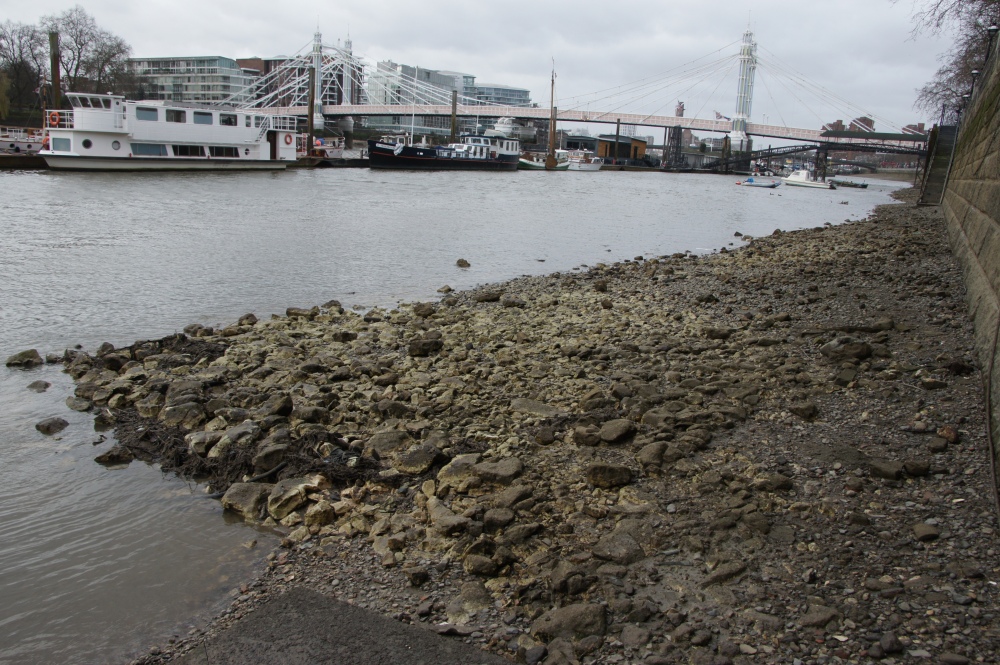
Forays on the foreshore
I spent a couple of cold and soggy hours in January walking along the Chelsea Embankment and foreshore looking for archaeological sites and remains. Much of the information I have gathered so far has been from historic documents and mapping, both of which are fairly biased records of activity in the past. As such, the identification and assessment of archaeological remains associated with 19th century activity on and around the waterfront is a vital addition to my research.
The Thames Archaeology Survey (TAS), carried out a rapid recording of archaeological sites on the foreshore in London between 1996 and 1999. It aimed to locate, number and photograph all archaeological remains on the Thames foreshore in London. The survey was rapid and the recording minimal, often a position and a photograph. The interpretation of many sites is now questionable after decades of additional research into foreshore sites. The work done by the Thames Discovery Programme (TDP) volunteers and archaeologists has been instrumental in improving our knowledge and understanding of activity on the foreshore. In order to make use of this new knowledge, I was pleased to be able to lure TDP archaeologist Eliott Wragg down to Chelsea to join me on the foreshore for a few hours.
The aim of this first visit was to have a quick look at what was on the foreshore and get a feel for how useful, or otherwise, it would be to my research. Walking along the foreshore also gave me a completely different perspective on the Embankment itself, but I think I will write that up in a separate post. Our walkover survey was relatively fruitful and a number of interesting features were observed. Inevitably we found unidentifiable bits of wood, like the one below, numbered by TAS as FKN04 A119 and interpreted as a ‘mooring post?’. Our thoughts were that it was more likely to be part of a revetment or jetty structure, but it might require a bit more research to reach any kind of conclusion.

Eliott Wragg pondering over a timber and iron feature on the Chelsea foreshore.
We located a number of chalk bargebeds, more than had been picked up by TAS. These are areas of large chalk blocks or cobbles, which provided a stable surfaces on which barges could be beached. Unlike the bargebeds down stream, the Chelsea ones do not appear to have wooden containing revetments, but perhaps this is an area that requires a bit more investigation. Bargebeds do not generally appear on historic mapping, and without excavation and the recovery of dateable objects, are very difficult to date. They may have their origins in the late medieval period, but this photograph from 1929 shows they were still being laid in the early 20th century. Whatever the date, the Chelsea ones certainly pre-date the 1870s Embankment and are likely to have been important points of activity on the foreshore in the 19th century. Bargebeds would have been located close to jetties, wharves and onshore businesses and I am hopeful that historic mapping and business directories will help link the sites with the pre-embankment businesses.

One of the many barge beds we spotted.
One of the other interesting site types we found were peat outcrops, including one with an acorn in! Whilst not directly relevant to my research on 19th century activity, the presence of peat outcrops is of archaeological interest, and these are likely to be prehistoric in date.

An acorn embedded within some of the prehistoric peat eroding out of the foreshore
Overall, this first trip was not only interesting, but also reassuring. There is pre-embankment archaeology on the foreshore (phew) and I think it will help me find out what the social and economic impacts of the Embankment construction was. Thankfully. That is a relief!